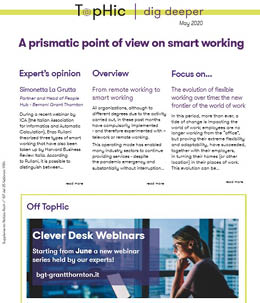-
Transactional advisory services
Find out more about the transactional advisory services of Grant Thornton Financial Advisory Services
-
Valuations
Find out more about the valuations services of Grant Thornton Financial Advisory Services
-
Mergers and acquisitions
Find out more about the merger and acquisition services of Grant Thornton Financial Advisory Services
-
Forensic and investigation services
Find out more about the forensic and investigation services of Grant Thornton Financial Advisory Services
-
Recovery & reorganisation
Find out more about the Recovery & reorganisation services of Grant Thornton Financial Advisory Services
-
Business risk services
Find out more about the business risk services of Grant Thornton Financial Advisory Services
-
Business consulting
Find out more about the business consulting services of Grant Thornton Financial Advisory Services
-
Capital market
Capital market
-
Corporate and business tax
Find out more about our corporate and business tax services.
-
Direct international tax
Find out more about our direct international tax services.
-
Global mobility services
Find out more about our global mobility services.
-
Indirect international tax
Find out more about our indirect international tax services.
-
Transfer pricing
Find out more about our transfer pricing services.
-
Litigation
Our lawyers and accountants can manage all defense measures provided not only by the Italian law, but also by EU regulations and conventions
-
Family business
Find out more about our Family business services.
-
Legal
The client can be assisted in every need and with the same care both on important operations or disputes and on simple matters

-
Back office outsourcing
Find out more about our Back office outsourcing services
-
Business process outsourcing
Find out more about our business process outsourcing services.
-
Compilation of financial statements
Find out more about our compilation of financial statements services.
-
Tax compliance
Find out more about our tax compliance services.
-
Electronic invoicing
Find out more about our electronic invoicing services
-
Electronic storage
Electronic storage is an archiving procedure that guarantees the legal validity of a digitally stored electronic document
-
Revaluation of corporate assets
Find out your civil and fiscal revaluation of tangible, intangible and financial assets
-
Payroll
Complete and customized payroll service, integrated with digital solutions and compliant with Italian and international regulations.
-
Labor consultancy
We help Italian and international companies manage all aspects of their workforce.
-
HR & Payroll Advisory Services
We review contracts, payroll, and risks for extraordinary transactions and we assess tax, labor, and safety risks in outsourcing contracts.
-
Extended services
We provide integrated digital tools to simplify HR management.
-
HR Infinity Portal
The HR Infinity Portal is Zucchetti’s platform designed to centralize communication between the company and its employees.
-
Cybersecurity
GT Digital helps clients structure information security management internal functions, also through partially or totally outsourced functions
-
Agile and Programme Management
GT Digital provides support in the adoption and implementation of different portfolio management
-
Robotic Process Automation
Our “BOT Farm” can rely on digital workers able to help clients in routine activities, allowing employees to deal with more added-value activities
-
Data strategy and management
GT Digital can support clients in seizing the opportunities offered by Big Data, from the definition of strategies to the implementation of systems
-
Enterprise Resource Planning
We support clients in selecting the most appropriate ERP System according to their specific needs, helping them also understand licensing models
-
IT strategy
GT Digital supports clients in making strategic choices, identifying innovation opportunities, comparing themselves with competitors
-
IT service management
We can support with software selection and with the implementation of dedicated tools for the management of ICT processes
-
DORA and NIS 2
The entry into force of the DORA Regulation and NIS2 represents a major step towards the creation of a harmonised regulatory framework
The different types of smart working
During a recent webinar by ICA (the Italian Association for Informatics and Automatic Calculation), Enzo Rullani theorized three types of smart working that have also been taken up by Harvard Business Review Italia[1].
According to Rullani, it is possible to distinguish between:
- Executive smart working: it consists of a standard managerial remote working activity, not occasional, structured, carried out with limited autonomy and continuous participation. It is possible to believe that such standard activities in the future may be carried out by machines or algorithms, without or with limited human input;
- Adaptive smart working: it is a remote working activity with relative independence for activities that are often demand and tailored, without specific constraints of space and time, with the possibility of participation in the objectives and with continuous learning on the job (some management, commercial or assistance and/or consultancy activities in technical or financial areas may be an example);
- Creative smart working: it implies forms of work having autonomy and involving personal participation, able to face conditions of complexity and continuous innovation, with measurable results, for example, in terms of project and with lifelong learning, including in terms of personal commitment. Typical of this type of work are research and project activities, software development, creative marketing.
These are very diverse forms that, as one can see from their description, respond to heterogeneous needs and for which an equally different evolution over time is expected.
The direction and course of the innovating forces underlying the development of the three theoretical operating modes appear, however, common: it is a progressive, but constant, transformation of telework into smart working.
Digital nomadism
In recent years and, particularly, in recent months, it has been well demonstrated that digital technology and its increasingly more conscious, planned and organized application to working activities have modified the concept and the value of closeness. Being close to clients, relating to suppliers, organising the team’s activities, and interacting within a work group do not require a physical presence any more, without this to significantly prejudice efficiency or operating effectiveness.
The use of new technologies allows a further optimization of time, which is the only rigid, inextensible and non-multipliable factor of production. It is agreed that, without distracting one’s attention, short messages can be sent via chat while on a video conference. This increases closeness and subsequently, in a wider perspective, favours a quicker completion of one’s own and others’ working activities, as well as the achievement of working goals.
This is one of the pillars of the evolution of remote working towards smart working, i.e. being aware that the use of technology does not generate a decrease in interpersonal relations but, on the contrary, it can grant higher promptness, efficiency and effectiveness. In an intentional evolutionary process (i.e. not suffered due to the current serious circumstances), “business processes and behaviours will need to be carefully analysed and re-designed in a digital perspective, reassembling the physical and digital dimension into an innovative combination4”.
Implementation process
As mentioned, a conscious and structured implementation of one of the possible smart working options starts from the identification of the business organizational model and of the interconnections between internal and external functions, as well as from the tracing of relations among the functions covered by employees.
Once such mapping activity is finalized, further difficult phases concern the definition of objectives, which necessarily originate also from the ethical values shared within the organisation, the identification of structural gaps (mainly digital ones, also concerning the safeguard of proper privacy levels) and of the actions needed to close them, the definition of the scope of the actions (which could originally concern the whole workforce), etc. However, it is also important to understand the relevance of a proper training for a correct implementation of such an innovation process.
Sharing targets, first, and developing employees’ awareness, then, are the cornerstones of the implementation process. As it usually happens during organizational changes, the implementation of a cultural change is the most delicate phase, which most of the times determines the success or failure of the project. A new operating mode needs to be learnt, in order to understand its potential and limits, to recognise and manage its criticalities, and to maximise its potentialities.
Diversity & Inclusion
A modernization process aimed to implement the culture of smart working is certainly relevant within the scope of Diversity & Inclusion policies. The use of unified communication and collaboration platforms cancels distance almost totally, maximises closeness and leads (finally) to a reduction of what is perceived as “absence from the workplace”, which on the contrary is a mere adoption of flexible working hours that allow a proper co-management of working and personal life.
A modernization policy in this direction could be key to allow an equal, serene, and effective co-existence of two goals that have always been seen as opposed, i.e.: a desired family realization (and the management of emergencies) and the achievement of professional goals for the whole working life. It is extremely clear, most of all to new generations, that these are actually not conflicting and divergent interests, but they are rather converging towards a more balanced and complete realization of human beings.
Conclusions
The epidemiologic emergency that we are currently facing has allowed us to acknowledge and appreciate the potential of new technologies, in general and, particularly, of sharing and collaboration platforms, acquiring a greater awareness of the impact that these can have on working processes that are too bound to space-time ties, which have now had their day. It can be recurrently noticed that a proper work/life balance is the first driver for choosing an organization, especially for those that have been working for no more than five years.
Therefore, it is now necessary to shift to new organisational models which, besides labour law definitions, lead to a cross-implementation of smart working, as defined in this article. The role of training is crucial in this as in other evolution processes of an organisation, as it is aimed at creating the required cultural change. As known in educational contexts, learning is an important social and national integration mean, a pillar to build a sense of community. It therefore aims not only to develop the individual, but also to help individuals build a common future, a shared experience.


